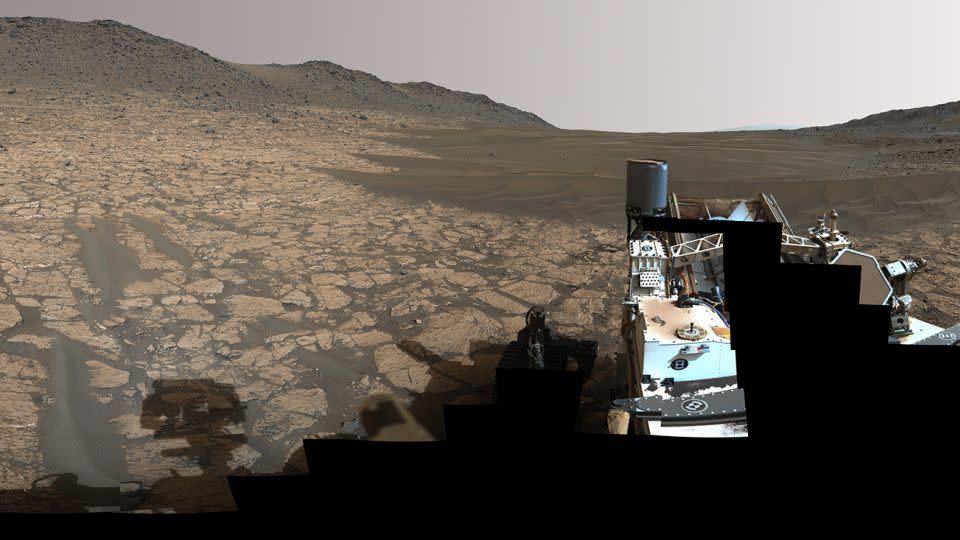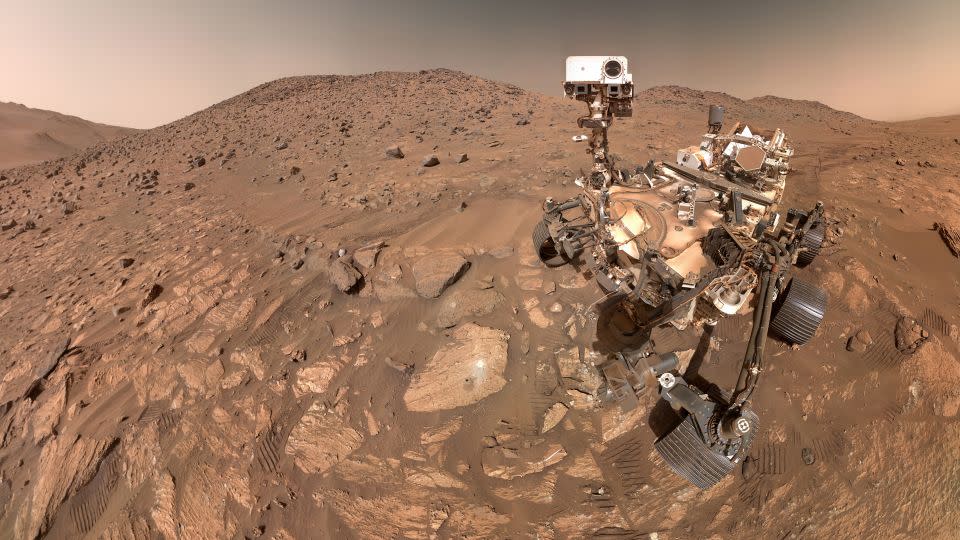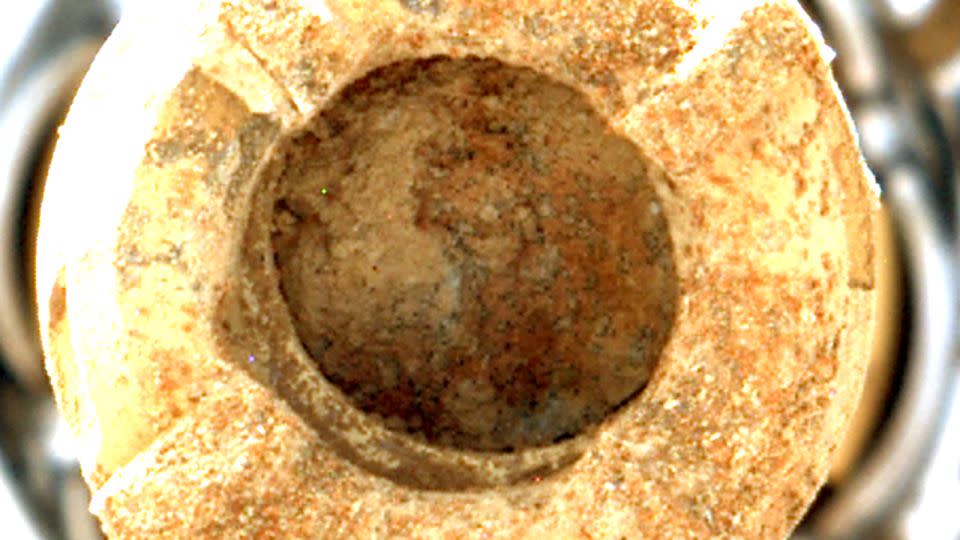Sign up for CNN’s Wonder Theory science newsletter. Explore the universe with news about fascinating discoveries, scientific advances and more.
NASA’s Perseverance rover may have found a key clue for its mission to Mars: geological evidence that could suggest life existed on the red planet billions of years ago.
The robotic explorer came across a vein-filled red rock that appeared to be dotted with leopard spots on July 18. The mottling may indicate that ancient chemical reactions taking place within the rock once supported microbial organisms.
“These spots are a big surprise,” David Flannery, an astrobiologist at Queensland University of Technology in Australia and member of the NASA Perseverance science team, said in a statement. “On Earth, these kinds of features in rocks are often associated with fossilized records of microbes living underground.”
The research is still preliminary and NASA scientists have yet to confirm how the rock was formed, which would require studying it on Earth. But the arrowhead-shaped sample could help the Perseverance team reveal whether Mars was once a habitable planet.
“We are really excited to have this sample in the bag!” Briony Horgan, co-investigator of the Perseverance exploration mission and professor of planetary science at Purdue University in West Lafayette, Indiana, said in an email.
“This rock is exactly the type of sample we came to Mars to find, and we can’t wait to get it to our labs on Earth,” he said. “This is exactly the type of potential microbial biosignature that NASA envisioned when designing the Mars 2020 mission, and we’ve used every instrument on our payload to find and understand this rock.”
Searching for signs of ancient life on Mars
Nicknamed Cheyava Falls after one of the Grand Canyon’s waterfalls, the rock attracts the attention of scientists for many reasons.
White veins of calcium sulfate provide clear evidence that water — crucial for life — once moved through the rock. The rover used its Scanning Habitable Environments for Organics and Chemicals with Raman and Luminescence, or SHERLOC, instrument to identify organic carbon-based molecules within the rocks.
In a video shared by NASA’s Jet Propulsion Laboratory in Pasadena, California, Morgan Cable, a research scientist on the rover team, said the irregularly shaped leopard spots tested by the PIXL instrument, which stands for Planetary Instrument for X-ray Lithochemistry, detected iron and phosphate within the features.

“We’ve never seen these three things together on Mars before,” Cable said.
The team also detected the potential presence of hematite among the white bands of calcium sulfate in the rock. Hematite is one of the minerals responsible for Mars’ signature red hue.
Leopard spotting may have occurred when chemical reactions with hematite turned the rock from red to white, releasing iron and phosphate and potentially creating black rings. Such reactions may also provide an energy source for microbes.
“Cheyava Falls is the most surprising, complex and potentially important rock ever explored by Perseverance,” Ken Farley, Perseverance project scientist and professor of geochemistry at the California Institute of Technology in Pasadena, said in a statement.
The team also discovered millimeter-sized crystals of olivine in the same rock. Olivine, a mineral formed from magma, has been previously detected by Perseverance elsewhere in the crater. The olivine found in the Cheyava Falls rock may be related to rocks that formed elsewhere in the valley, the team said.
The rover team is grappling with a multitude of questions as it examines the rock and tries to determine what processes might have formed it.
Cheyava Falls may have started as a mixture of accumulated mud and organic compounds that eventually hardened into rock. Water may then have penetrated through cracks in the rock, depositing minerals to form calcium sulfate veins and leopard spots.
But it’s also possible that olivine and sulfate became part of the rock due to the extreme temperatures on Mars, causing a non-biological chemical reaction that created the leopard spots.
Exploring Mars’ past
Since landing on Mars, Perseverance has passed through Jezero Crater and explored an ancient river delta in search of microfossils of past life, collecting samples along the way that could be brought back to Earth by future missions.
More recently, Perseverance explored the northern rim of Neretva Vallis, an ancient river valley that brought water to Jezero Crater more than 3 billion years ago, and found Cheyava Falls there. The rover landed inside the crater in February 2021 to explore the former lake area.


Geologists on the rover team wanted Perseverance to study rocks that had been formed or altered by water on Mars in the past, so Cheyava Falls was of interest to them.
“We designed the route for Perseverance to take it to areas that have the potential for interesting scientific samples,” Nicola Fox, associate administrator for NASA’s Science Mission Directorate, said in a statement. “This journey through the Neretva Vallis riverbed paid off because we found something we’ve never seen before, and it’s going to give our scientists a lot to study.”
The difficult path to finding evidence of life
NASA announced in April that Mars Sample Return, the original complex, multi-mission design for the program that was intended to bring Perseverance’s samples back to Earth, was no longer viable in its current architecture due to budget cuts and a delayed return date.
The agency called on NASA centers and industry to develop a new plan that combines innovation with lessons learned from proven technology. NASA leadership hopes to return samples to Earth by the 2030s with less complexity, cost and risk than originally planned, and the agency expects to have answers on how best to return samples from Mars by the fall, NASA Administrator Bill Nelson said at a press conference in April.


In the meantime, Perseverance continues its critical exploration work on Mars and will soon begin climbing to the rim of Jezero Crater.
“This discovery comes at a critical time when NASA is reevaluating the best way to get these samples back from Mars through Mars Sample Return,” Horgan said. “It shows how important and unique our samples are, and how much we can learn about the origins of life on Earth-like planets. It’s also fitting that Jezero has one last surprise in store for us before the crater floor begins to climb up the rim, leaving behind ancient river and lake sediments.”
The Perseverance team says returning samples is the only way to know if there is life on Mars.
“We irradiated this rock with lasers and X-rays and imaged it from every conceivable angle, literally day and night,” Farley said. “Scientifically, Perseverance has nothing more to offer. We want to bring the Cheyava Falls sample back to Earth so it can be studied with powerful instruments in the labs to understand exactly what really happened in that Martian river valley in Jezero Crater billions of years ago.”
For more CNN news and bulletins, create an account at CNN.com